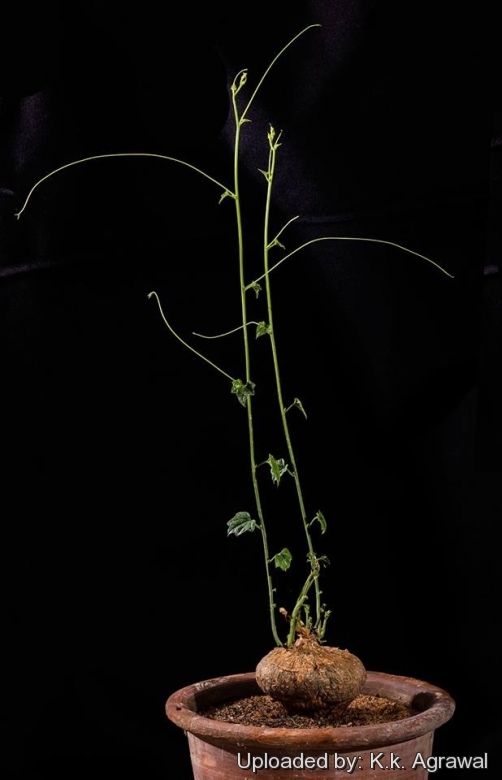
Cyclantheropsis parviflora Photo by: K.k. Agrawal
Origin and Habitat: From Ethiopia to S tropical Africa (Malawi, Mozambique, Kenya, Zambia, Tanzania, Zimbabwe, Namibia, and Southern Africa)
Altitude range: 75-1150 metres above sea level.
Type locality: Tanzania, Zanzibar.
Habitat and ecology: It grows in lowland evergreen forests, deciduous woodland and bushland. It is also found in dry montane forest, rocky hilltops and ravines.
Synonyms:
See all synonyms of Cyclantheropsis parviflora
back
Accepted name in llifle Database:Cyclantheropsis parviflora HarmsBot. Jahrb. Syst. 23(1-2): 169. 1896 [15 Sep 1896]Synonymy: 3
back
Description: Cyclantheropsis parvifloraSN|28019]]SN|28019]] is a very striking and unusual desert plant in the Cucurbitaceae (Pumpkin/Melon family) with climbing vine and a large convex caudex, it produces minuscle male and female flowers in separate plants in summer and compressed, leathery winged fruits (samarras), not immediately suggesting of Cucurbitaceae. Architecturally it is a real stunner. When the “caudex” shape is adequately in evidence this plant is incomparable. The plant is quite variable.
Habit: Dioecious, geophyte twining vine, the vine part is mostly perennial.
Rootstock (caudex): Swollen, tuberous convex and semi-subterranean.
Stems: Wiry, scandent or clinging to 5(-6) m long, herbaceous and puberulous when young, becoming more woody and grey-barked when older.
Leaves: Ovate or reniform-cordate in outline, 21-105 mm long x 32 -100 mm broad, usually shallowly 3-5 lobed, acute, apiculate, minutely puberulous, semisucculent. Petiole 10- 41 mm long.
Tendrils: Mostly unbranched.
Inflorescences: Inflorescences axillary, unisexual.
Male flowers: In many-flowered panicles to 120 mm long, hypanthium saucer-shaped. Sepals triangular, 0.7 mm long. Petals 1 mm long, pale greenish-yellow. Stamens 1, central.
Female Flowers: In 3-6 flowered panicles, greenish-yellow, 25 -45 mm panicles or racemes on 05-10 mm peduncles. Pedicels 4 -6 mm long. Petals 1.2 mm long. Style short. Ovary 3–6 mm long, 1–1.5 mm. across, compressed.
Fruits (samaras): 1–4, pendulous on 5–10 mm long pedicels, compressed, leathery, elliptic in outline, indehiscent, 31-55 mm long, 15-22 mm broad, winged, brownish when ripe.
Seeds: Solitary, elliptic and compressed, to 11 mm long; testa pale brown, slightly rough; germination hypogeal.
Bibliography: Major references and further lectures.
1) Urs Eggli “Illustrated Handbook of Succulent Plants: Dicotyledons” Springer Science & Business Media, 2002
2) Klaus Kubitzki “Flowering Plants. Eudicots: Sapindales, Cucurbitales, Myrtaceae” Springer Science & Business Media, 10/Dec/2010
3) C. Jeffrey “Flora of Tropical East Africa”, page 1 1967
4) C. Jeffrey “Cucurbitaceae” in: Flora Zambesica. Vol 4 page 414 1978
5) Royal Geographical Society (Great Britain), Institute of British Geographers “Mkomazi: the ecology, biodiversity and conservation of a Tanzanian Savanna” Royal Geographical Society (with The Institute of British Geographers), 1999
6) Meeuse, A.D.J. “The Cucurbitaceae of southern Africa.” in: Bothalia 8: 1-111.1962
 Cyclantheropsis parviflora Photo by: K.k. Agrawal
Cyclantheropsis parviflora Photo by: K.k. AgrawalSend a photo of this plant.The gallery now contains thousands of pictures, however it is possible to do even more. We are, of course, seeking photos of species not yet shown in the gallery but not only that, we are also looking for better pictures than those already present.
Read More... Cultivation and Propagation: It grows well, though very slowly, but it possible to increase the speed of growth to some extent by providing adequate amount of water, warmth, and fertilizer during the active growing season, but it’s susceptible to rotting if too wet. It likes a sunny position, but avoid direct blasting sun in summer. It should be watered regularly in Summer and kept drier in Winter. It like pots with generous drain holes, need a very porous, slightly acidic potting medium (add pumice, vulcanite, and perlite). It can be grown outdoors in frost-free climates, need anyway to kept above 0°C and dry in winter.
Maintenance: Repot every two years.
Propagation: Seeds or cuttings.











